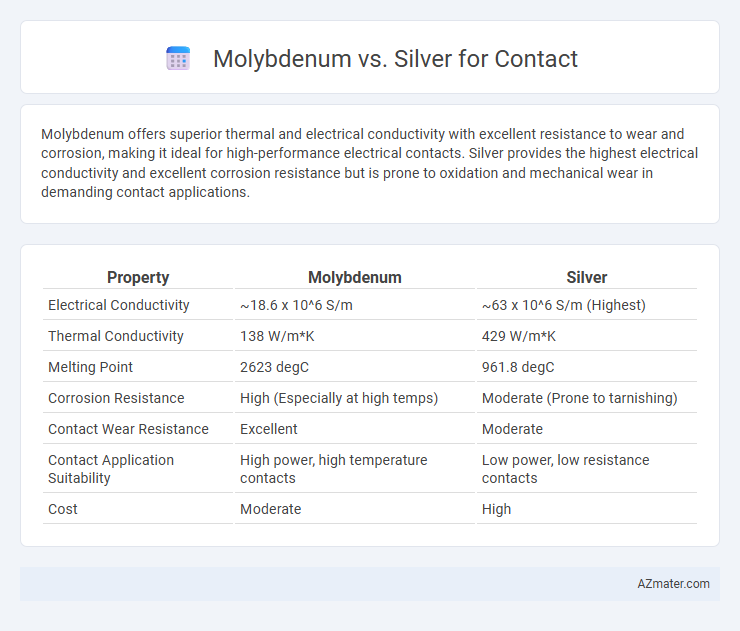Molybdenum offers superior thermal and electrical conductivity with excellent resistance to wear and corrosion, making it ideal for high-performance electrical contacts. Silver provides the highest electrical conductivity and excellent corrosion resistance but is prone to oxidation and mechanical wear in demanding contact applications.
Table of Comparison
| Property | Molybdenum | Silver |
|---|---|---|
| Electrical Conductivity | ~18.6 x 10^6 S/m | ~63 x 10^6 S/m (Highest) |
| Thermal Conductivity | 138 W/m*K | 429 W/m*K |
| Melting Point | 2623 degC | 961.8 degC |
| Corrosion Resistance | High (Especially at high temps) | Moderate (Prone to tarnishing) |
| Contact Wear Resistance | Excellent | Moderate |
| Contact Application Suitability | High power, high temperature contacts | Low power, low resistance contacts |
| Cost | Moderate | High |
Introduction to Electrical Contact Materials
Molybdenum and silver are critical materials used in electrical contacts due to their unique conductive and mechanical properties. Molybdenum offers high melting point and excellent resistance to arc erosion, making it suitable for high-load applications, whereas silver provides superior electrical and thermal conductivity essential for low-resistance contacts. The choice between molybdenum and silver depends on the balance of conductivity, durability, and environmental conditions in electrical switching devices.
Overview: Molybdenum and Silver Properties
Molybdenum exhibits high melting point (2,623degC), excellent thermal conductivity, and strong resistance to corrosion, making it suitable for high-temperature electrical contacts in harsh environments. Silver offers superior electrical conductivity (6.30 x 10^7 S/m) and thermal conductivity, but lower melting point (961.8degC) and susceptibility to tarnish can affect contact reliability. Both metals are critical in contact manufacturing, with molybdenum favored for durability and silver preferred for conductivity.
Electrical Conductivity: Molybdenum vs Silver
Silver exhibits the highest electrical conductivity among all metals, rated at approximately 63 x 10^6 S/m, making it the superior choice for electrical contacts requiring minimal resistance. Molybdenum, with an electrical conductivity around 19 x 10^6 S/m, offers significantly lower conductivity but compensates with excellent mechanical strength and resistance to oxidation under high temperatures. For applications demanding maximal current flow and minimal energy loss, silver contacts outperform molybdenum, whereas molybdenum suits environments where durability and thermal stability are critical.
Thermal Conductivity Comparison
Molybdenum exhibits a thermal conductivity of approximately 138 W/m*K, which is significantly lower than Silver's thermal conductivity of about 429 W/m*K, indicating Silver's superior heat transfer capability in electrical contacts. The high thermal conductivity of Silver improves heat dissipation in high-current applications, reducing the risk of overheating and contact degradation. Molybdenum's moderate thermal conductivity combined with its excellent mechanical strength makes it suitable for contacts requiring durability under thermal stress despite less efficient heat conduction.
Corrosion Resistance and Durability
Molybdenum offers superior corrosion resistance compared to silver, especially in high-temperature and chemically aggressive environments, making it ideal for durable electrical contacts. Silver provides excellent electrical conductivity but is prone to tarnishing and corrosion when exposed to sulfur compounds, reducing long-term durability. Molybdenum's robust oxidation resistance and mechanical strength contribute to longer contact life in demanding industrial applications.
Mechanical Strength and Wear Resistance
Molybdenum exhibits superior mechanical strength compared to silver, making it more resistant to deformation under high stress conditions in electrical contacts. Silver, while possessing excellent electrical conductivity, tends to have lower wear resistance due to its softness and susceptibility to surface abrasion in sliding or high-load contacts. The wear resistance of molybdenum contributes to longer-lasting contact performance, especially in applications involving frequent mechanical cycling or harsh environmental conditions.
Cost and Availability Factors
Molybdenum offers a cost advantage over silver due to its lower raw material price and greater abundance, making it more economically feasible for large-scale industrial contacts. Silver, despite superior electrical conductivity, has higher costs linked to its premium market value and limited availability, which can impact budget-sensitive projects. Availability challenges for silver include geopolitical supply constraints, whereas molybdenum benefits from more geographically diverse mining operations, ensuring steadier procurement.
Common Applications in Electrical Contacts
Molybdenum is widely used in electrical contacts for high-temperature and high-current applications due to its excellent thermal conductivity and resistance to arc erosion. Silver, known for the highest electrical conductivity and superior corrosion resistance, is commonly applied in low-resistance switches, relays, and connectors requiring reliable performance under normal operating conditions. Both metals serve critical roles in contact materials, with molybdenum favored in harsh environments and silver preferred for precision and efficiency in electronic devices.
Environmental and Safety Considerations
Molybdenum contacts exhibit superior environmental resilience, resisting corrosion and oxidation better than silver, which tarnishes and degrades when exposed to sulfur compounds or moisture. Silver, while offering excellent electrical conductivity, poses potential safety concerns due to its propensity to form silver sulfide, which can impair performance and necessitate more frequent maintenance. Molybdenum's stability in harsh environments reduces hazardous waste and promotes longer component life, aligning with sustainable and safety-focused practices in electronics manufacturing.
Conclusion: Choosing the Right Material
Molybdenum offers superior resistance to arc erosion and excellent mechanical strength, making it ideal for high-wear electrical contacts in demanding industrial applications. Silver provides exceptional electrical conductivity and thermal performance, which benefits low-resistance connections in electronics and consumer devices. Selecting the right contact material depends on balancing conductivity requirements with durability needs specific to the operating environment.

Infographic: Molybdenum vs Silver for Contact
 azmater.com
azmater.com